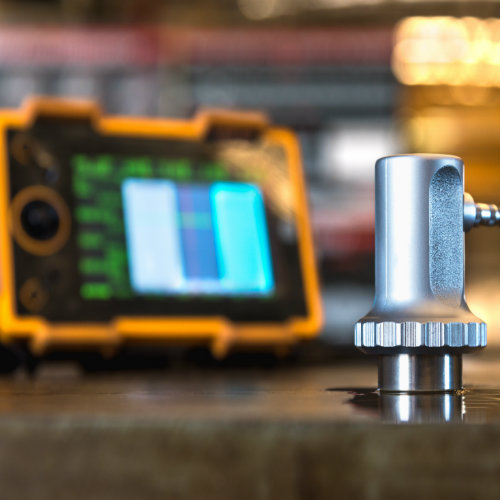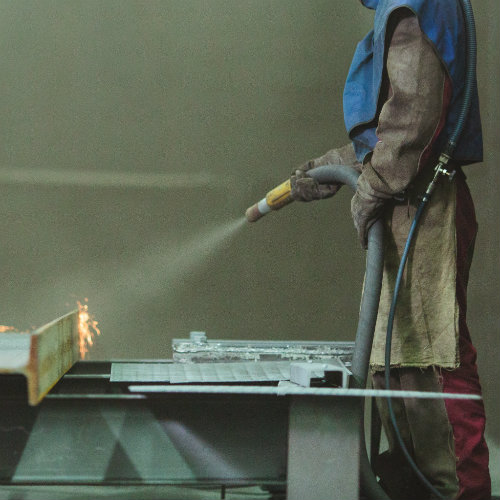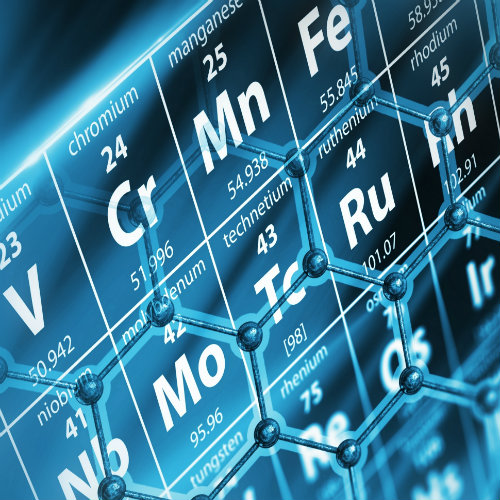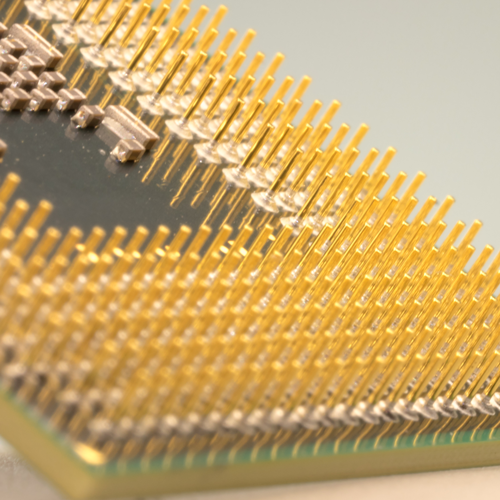Advanced Chem-Film Services For Aerospace And Defense
In the ever-evolving aerospace and defense industries, chem-film treatment is an essential process in the aerospace and defense industries, where durability and reliability are paramount. This specialized coat, also known as chemical film or conversion coating, is applied to metal surfaces to increase resistance to corrosion and wear while preparing surfaces for additional coatings or paints.
A leader in this precise field, Valence offers unparalleled chem-film services tailored to meet specific industry requirements. In this comprehensive guide, we will explore the intricacies of chem-film, its applications, and why Valence stands out as the premium provider.
What Is Chem-Film?
Chem-film is a chemical conversion coating that’s primarily applied to aluminum to enhance corrosion resistance and improve surface conductivity. This treatment forms a thin protective layer on the metal that also serves as a prime surface for subsequent coating applications. The process doesn’t change the part’s dimensions, which is crucial for maintaining tight tolerances in aerospace components.
The Science Behind Chem-Film’s Superior Surface Finishing
The effectiveness of chem-film comes from its ability to convert metal surfaces into a protective layer, which integrates chemically with the substrate. This molecular bond is exceptionally durable and offers superior protection compared to traditional paint or surface coverings. The science ensures that each treated surface provides an additional defense against environmental stressors.
The Types And Classes Of Chem-Film
Type I Vs. Type II Chem-Film
Chem-film coatings are available in various types. Type I chem-film uses hexavalent chromium in its composition and is known for its supreme protection levels. Type II, on the other hand, is a more environmentally friendly option that utilizes trivalent chromium, offering sufficient protection while meeting current environmental standards.
The Classifications Of Chem-Film
Chem-film treatment also varies in classes, designated as Class 1A and Class 3. Class 1A coatings offer maximum corrosion prevention and paint adhesion, making it ideal for parts requiring extensive protection. Class 3 coatings are thinner and typically used for electrical conductivity without adding significant weight or altering dimensions.
Customizing Chem-Film Treatments
Valence understands the need for customized solutions. Depending on the component application and requirements, Valence can adjust the chem-film process, whether it be for robust protection in harsh environments or ensuring precise electrical properties for sensitive instruments.
Importance Of Specifying The Right Chem-Film
Correct specification is critical in achieving desired results. Valence’s team of experts helps customers navigate the complexities of chem-film types and classes, ensuring the perfect match for their components’ ultimate performance and longevity.
The Role Of Chem-Film In Aerospace And Defense
Increased Lifespan Of Components
In the demanding conditions of aerospace and defense, component lifespan is crucial. Chem-film treatments from Valence play a significant role in extending the functional life of parts, meaning more reliability and less frequent need for replacement.
Ensuring Component Compliance And Safety
Aircraft and defense equipment must comply with strict regulations. Chem-film treatments are integral to ensuring that parts meet these standards. Valence’s adherence to industry specifications means that every component treated not only meets but often exceeds regulatory compliance, ensuring the safety of equipment and personnel.
Streamlining Manufacturing And Maintenance
Chem-film allows for easier manufacturing and maintenance of components. This surface treatment acts as a preparatory step for further coatings, simplifying the production process. Maintenance becomes more straightforward as well, with treated parts demonstrating a higher level of resilience to corrosion and wear, thanks to Valence’s quality chem-film processes.
Why Valence Is The Premier Chem-Film Provider
Valence stands out in the field of surface treatment, offering unmatched expertise and customized chem-film services that are hard to find elsewhere. Their state-of-the-art facilities, coupled with decades of experience providing chem-film solutions, make them the first choice for aerospace and defense contractors who demand excellence.
Quality Assurance And Valence’s Commitment To Chem-Film Excellence
Certified Quality Control
Valence prides itself on its rigorous quality control procedures, operating under the most stringent standards to maintain certifications such as Nadcap, AS9100, and ISO 9001. Their chem-film treatments not only undergo rigorous testing to ensure the highest levels of quality but also see consistent upgrades in testing protocols to match the dynamic nature of industry requirements.
Strict Adherence To Industry Standards
Valence’s commitment to precision is reflected in their unwavering adherence to industry standards, ensuring that their chem-film processes consistently produce results that meet or exceed all relevant regulatory requirements. This meticulous approach fosters trust and confidence, offering their clients coatings of unparalleled excellence that they can depend on.

Advanced Process Monitoring And Control
Valence’s superior performance in chem-film applications is underpinned by their advanced process monitoring and control systems. These ensure consistent quality and enable Valence to immediately identify and rectify any deviations, proving their commitment to excellence and resulting in the reliable performance of treated components in the field.
Continuous Improvement And Innovation
Innovation is synonymous with Valence’s philosophy. Their pursuit of continuous improvement manifests in relentless refinement of their chem-film processes and exploring novel solutions to meet evolving client needs. This progressive approach ensures Valence remains at the forefront of the chem-film service industry, always delivering cutting-edge and effective solutions.
Chem-Film Applications In Commercial And Business Aviation
Protection For Aircraft Exteriors
Valence’s chem-film services not only offer superior protection for aircraft exteriors against environmental factors but also enhance the resistance of these surfaces to the mechanical stresses encountered during flight operations. This dual-action defense helps maintain aircraft’s structural integrity from the unpredictable nature of high-altitude weather to the rigors of daily operations, ensuring that aircraft can remain in service longer with less need for costly repairs.
Interior Component Durability
Within the confines of a commercial aircraft cabin, every component matters for the safety and comfort of passengers. Valence’s chem-film treatments extend beyond mere surface protection, they imbue interior components with enhanced durability—reducing wear in high-contact areas such as luggage compartments and seating fixtures. This not only contributes to passenger safety but also reflects the airline’s commitment to quality in every detail of their service.
Streamlined Maintenance For Business Aviation
Valence understands that in business aviation, time is a resource as valuable as the aircraft itself. Their chem-film treatments are integral to minimizing downtime, ensuring that maintenance procedures are less frequent and more efficient, and keeping the jets looking pristine. By preserving the aesthetic qualities of business aircraft and ensuring their reliable performance, Valence helps operators make a statement of excellence with every flight.
The Benefits Of Chem-Film For Corrosion Resistance
Natural Environmental Barrier
Chem-film naturally shields surfaces from corrosive elements, thus increasing the durability of metal components. Valence harnesses this property to the fullest, treating components so they can withstand numerous environmental challenges.
Foundation For Further Coatings
Acting as an excellent foundation, chem-film ensures better adhesion of paints and other coatings. Valence’s application ensures a uniform surface that holds subsequent coatings more effectively.
Long-Term Cost Savings
Investing in chem-film treatment offers significant long-term cost savings by reducing the need for frequent maintenance and replacements. Valence provides this cost-efficient solution without compromising on quality or performance.
Enhanced Equipment Reliability
Corrosion resistance means heightened reliability of equipment. Valence recognizes the importance of dependable components in critical missions, which is where their chem-film services demonstrate tangible benefits.
Why Trusted Aerospace Leaders Choose Valence For Chem-Film
Comprehensive Capabilities
Valence distinguishes itself by housing the broadest range of aerospace surface technology solutions, including chem-film treatments, all in one place. This expansive capability offers clients the convenience and confidence of a complete solution, tailored to their specific needs. It’s this all-encompassing approach to surface treatment that secures Valence’s position as the provider of choice among industry leaders looking for comprehensive service offerings.
Proven Track Record
The reputation Valence has built is rooted in a history marked by excellence. Their consistent delivery of high-quality surface treatments time and again has established a proven track record that has drawn the trust and loyalty of the aerospace community’s most prestigious members. Their reliability in providing top-tier chem-film services is recognized across the industry and is a testament to their unwavering commitment to excellence.
Dedicated To Customer Success
Valence operates with a deep-seated commitment to the success of their clients. Every relationship is built on a foundation of collaboration, with Valence’s team of seasoned professionals engaging closely with clients to fully understand and achieve their project objectives. This personalized attention ensures that every outcome aligns with the clients’ strategic vision, fostering lasting partnerships rooted in customer satisfaction.
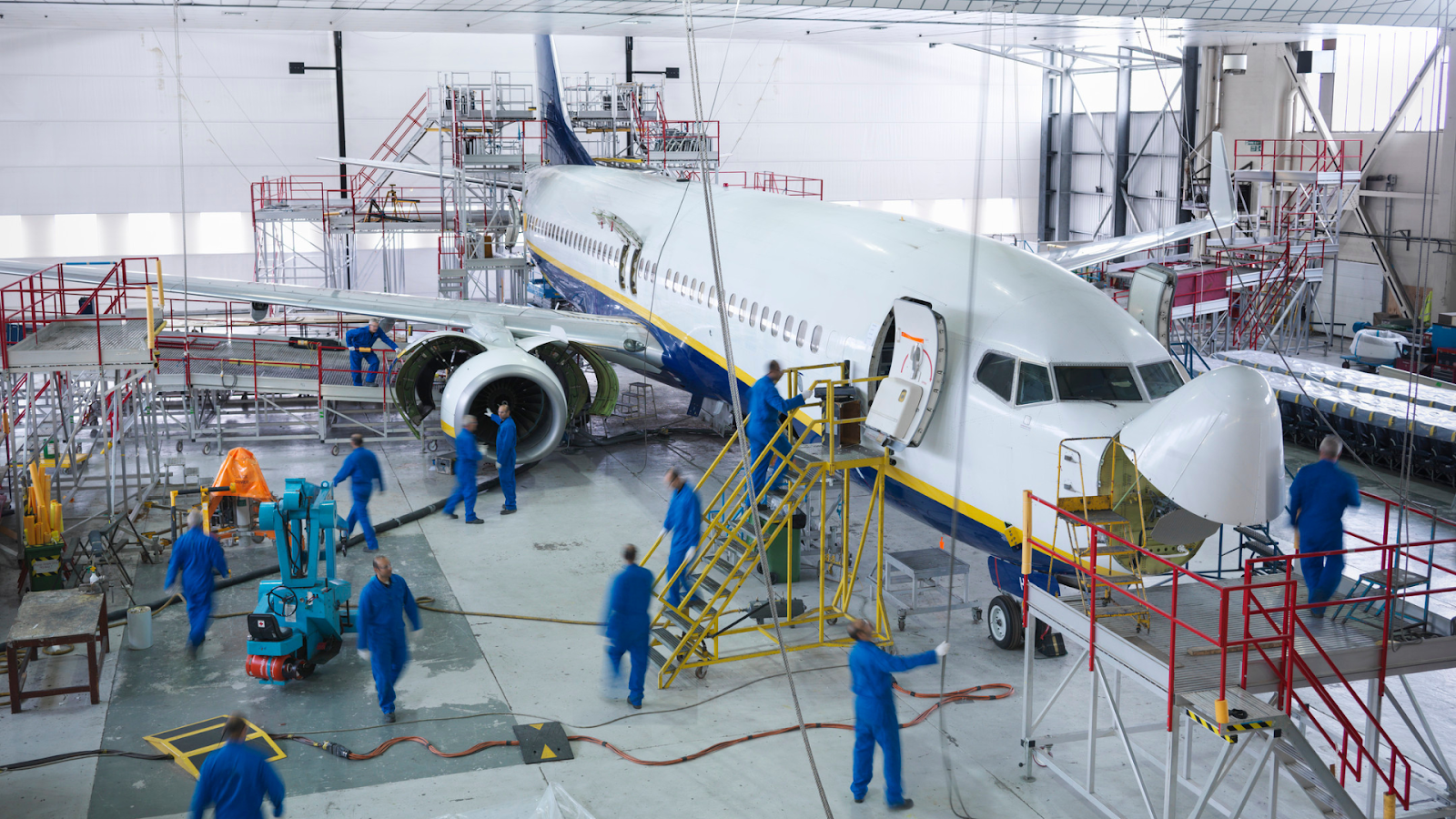
Industry-Leading Lead Times
Recognizing the value of time in the fast-paced aerospace industry, Valence’s streamlined processes yield industry-leading lead times without sacrificing quality. This efficiency offers aerospace leaders a significant competitive advantage, enabling quicker project turnovers and faster time-to-market for their innovations. Valence’s ability to meet tight deadlines while maintaining high standards is one of the many reasons they are the choice provider for those who cannot afford to wait.
Final Thoughts
As we conclude our exploration of chem-film treatments and the paramount role they play in the aerospace and defense industries, it’s clear that this surface finish is more than a simple coating; it’s a fundamental component of modern engineering design. It ensures that metal parts can endure the most challenging conditions while maintaining their structural properties and functionality.
In search of a chem-film provider that offers comprehensive services coupled with a dedication to quality and customer success, aerospace leaders repeatedly turn to Valence.
Frequently Asked Questions
What specific metals can undergo chem-film treatment?
Chem-film treatment is primarily applied to aluminum surfaces, although it can also be used on other metals like magnesium and titanium, depending on specific requirements.
How thick is the chem-film coating typically?
The chem-film coating typically ranges from 0.00001 to 0.00004 inches (0.25 to 1.0 microns) in thickness, maintaining the precise dimensions of the treated components.
Are there any post-treatment processes required after applying chem-film?
Depending on the application, parts might need rinsing, drying, or additional sealing processes to optimize the chem-film’s properties fully.
Can chem-film treatments be removed or reversed from a surface if needed?
Yes, there are processes available to remove chem-film coatings if necessary, although they might impact the underlying material surface.
What are some specific aerospace components that commonly undergo chem-film treatment?
Components such as aircraft structural parts, landing gear, brackets, and even internal fixtures like seating frames often undergo chem-film treatment.
Does chem-film treatment affect the electrical conductivity of parts?
Yes, depending on the type and class of chem-film used, it can impact the electrical conductivity of treated parts, especially in Type II Class 3 coatings designed for enhanced conductivity.
How does chem-film compare to other types of corrosion-resistant coatings like anodizing?
Chem-film and anodizing serve similar purposes but differ in their application methods and the properties they confer to the metal surface. Anodizing creates a thicker, more wear-resistant coating compared to chem-film.
Can chem-film treatments be applied to irregularly shaped or intricate parts?
Yes, chem-film processes can be adapted to treat complex shapes and intricate parts, maintaining uniform coverage.
Is chem-film environmentally friendly?
Type II chem-film, which uses trivalent chromium, is considered more environmentally friendly than Type I, which uses hexavalent chromium due to its lower toxicity.
Can chem-film-treated components be welded after treatment?
Yes, chem-film treatments do not inhibit welding processes, allowing treated components to undergo welding if needed.
Sources:
- Gubner, R. L. (1975). Chemical conversion coatings on aluminum alloys. Metal Finishing, 73(5), 34-42. https://www.researchgate.net/publication/234924635_Chromate_Conversion_Coating_on_Aluminum_Alloys_I_Formation_Mechanism
- Reimann, P., & Kühnel, W. (2020). New insights into the corrosion protection mechanism of chromic acid anodizing on aluminum: An in situ Raman spectroscopy study. Corrosion Science, 163, 108228. https://www.sciencedirect.com/science/article/abs/pii/S1005030222002705
- Cheng, S., et al. (2022). Effect of pre-treatment and deposition time on the properties of silane-based conversion coatings on AZ91D magnesium alloy. Surface and Coatings Technology, 450, 123778. https://www.sciencedirect.com/science/article/abs/pii/S0257897218310983
- Wu, X., et al. (2018). Investigation on the corrosion resistance and barrier properties of a novel water-based trivalent chromium conversion coating on aluminum alloy 2024-T3. Journal of Alloys and Compounds, 742, 1143-1154. https://www.sciencedirect.com/science/article/abs/pii/S0013468620306745
- Lee, H., et al. (2015). Effect of immersion time and sealing on the corrosion resistance of a silane-based conversion coating on AZ91D magnesium alloy. Materials Chemistry and Physics, 174, 244-251. https://www.scielo.br/j/mr/a/jp5gmrnZs5pFS4wPjPFm9my/abstract/?lang=en
- Huang, Y., et al. (2019). Effect of post-treatment with fluorinated silane on the corrosion resistance of a zirconium-based conversion coating on AZ91D magnesium alloy. Corrosion Science, 158, 107971. https://www.sciencedirect.com/science/article/abs/pii/S0010938X19319936
- Zhang, Q., et al. (2014). Study on the removal of chromium-containing conversion coatings from aluminum alloys. Journal of Materials Science and Technology, 30(12), 1109-1114. https://www.springer.com/journal/10853
- Wang, Y., et al. (2022). Environmentally friendly removal of chemical conversion coatings using a novel ionic liquid-based stripping solution. Journal of Cleaner Production, 348, 131201. https://www.sciencedirect.com/science/article/abs/pii/S1383586623000205
- Kainer, A., et al. (2006). Overview of aluminum alloy applications in aerospace and automotive industries. Journal of Materials Science, 41(15), 5090-5107. https://pubs.aip.org/aip/acp/article/2766/1/020027/2894944/Aluminum-and-its-alloys-in-automotive-and
- Gundel, D., & Shumaker, J. M. (2015). Chemical conversion coatings for titanium alloys: A review. Corrosion Reviews, 33(5-6), 233-250. https://www.degruyter.com/journal/key/corrrev/html?lang=en
These coatings are categorized by the following types and classes.
- Type I: Addresses compositions are containing hexavalent chromium. This chemical film typically appears to be gold or brown in color, but in some cases may be optionally specified as having no color. (Having no color is described as “clear.”)
- Type II: Addresses chemical film compositions containing no hexavalent chromium. This film typically appears to have no color. (Having no color is described as “clear.”)”
- Class 1A: These chemical conversion coatings provide corrosion prevention on unpainted items, and they improve adhesion of paint finish systems on aluminum and aluminum alloys. Metal surface coatings of this type may be used, for example, on tanks, tubing, and component structures where paint finishes are not required for interior surfaces but are required for the exterior surfaces.
- Class 3: These chemical conversion coatings provide a corrosion preventive chemical film for electrical and electronic applications where lower resistant contacts, relative to class 1A coatings, and anodic coatings in accordance with
MIL-A -8625, are required. Because Class 3 coatings are thinner, they are more susceptible to corrosion than class 1A coatings. If it is required to paint areas surrounding electrical, Class 3 coatings improve adhesion of paint systems on aluminum and aluminum alloy material.
Valence performs all of these services to the highest degree of care, with approvals for most prime and military specifications.
Request a quote on sulfuric anodizing for your application, or contact us with any questions.
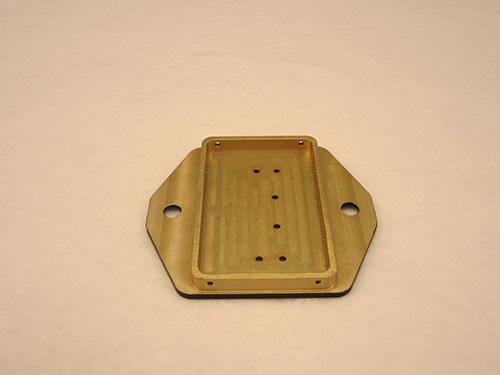
Chemical Film Process
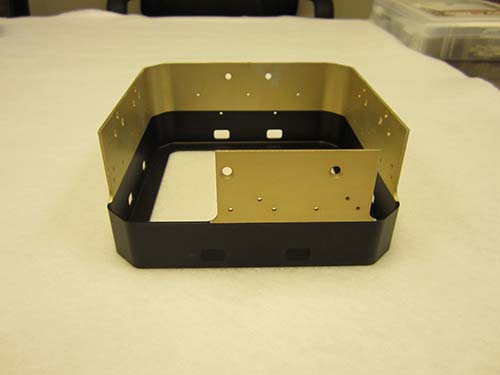
Chemical film mask black anodize processes
